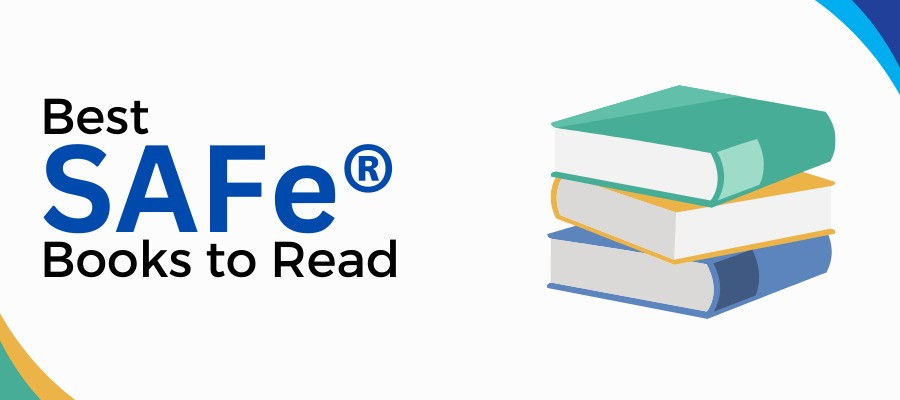Best SAFe® Books to read

Introduction
The Scaled Agile Framework, more often abbreviated as SAFe®, is a compilation of fundamental principles that define the culture of a business and the ideals that the leadership is intended to cultivate inside the firm. It sheds light on the necessary code of behavior that personnel working for a large-scale corporation are expected to follow.
What is SAFe®?
The Scaled Agile Framework, often known as SAFe®, is a collection of workflow and organizational patterns used to implement agile principles in large-scale businesses. This framework operates as a central repository of knowledge that provides ordered direction based on the roles, duties, time management, and fundamental values an employee must maintain. Not only does a properly executed Scaled Agile Framework encourage alignment and collaboration among agile teams, but it also facilitates large-scale delivery of work across multiple agile groups. As a result, operational work efficiency will improve after such a framework has been successfully implemented.
Best SAFe® Books to read
The Scaled Agile Framework, its inner workings, and the ideals it promotes inside a business can be better understood with the help of a reputable book on the subject. For those who want to learn the proper method to apply SAFe® in an organization, this article has compiled a collection of SAFe® Agile books for beginners to help you get started.
1. SAFe® 5.0 Distille
It's clear that if you want to learn about the Scaled Agile Framework, this book is the greatest resource to do so. This book will teach you how to implement the Scaled Agile Framework in your company. It was co-written by the person responsible for developing this framework. Thus, having a copy on hand might be helpful if you want to use it internally. The book "SAFe® 5.0 Distilled" is essential since it provides a comprehensive overview of the framework and its features. You'll take away some important principles and nifty implementation hints. The framework is updated every few years. This book's revised fifth edition includes the latest updates to skills, theories, and ideas.
2. The ART of Avoiding a Train Wreck
Aligning an Agile Release Train with various teams might provide several difficulties. This book is widely regarded as one of the greatest resources for learning about the SAFe® Agile framework. Any developer serious about adding this framework to his OS should consult this book. This book's reputation is unmatched since it was written by two of SAFe®'s most well-known practitioners. This book provides a comprehensive guide on putting Agile Release Train into practice.
3. Accelerate
Large-scale enterprises are more likely to confront several obstacles when managing projects in an agile manner. However, to make things simpler for you, John Kotter's book Accelerate details an organizational structure that simplifies Agile on a larger scale rather than making the process more difficult. The author refers to it as a Dual Operating System, which prepares the groundwork for reorganizing a business to provide room for future expansion.
4. Agile Software Requirements
In the repetitive Agile framework, it may be difficult to develop cutting-edge software requirements for optimum efficiency, particularly for large-scale operations. The book by Dean Leffingwell provides useful strategies, in-depth information, and concrete recommendations for addressing these obstacles.
As a result, it is considered one of the best SAFe® publications for software development companies. For businesses in need of solid Agile Software Requirements, this is the perfect resource for both engineers and executives.
5. Lean Product and Process Development
As more emphasis is placed on the need for businesses to be efficient at their core functions, research into the theory and practice of lean has progressed. Product development is one of the most important things to do. The Lean Enterprise Institute created this book to promote efficiency in the industry. This comprehensive guide on lean development, written by one of the field's early proponents, Allen Ward, offers a comprehensive look at the methodology and its ideas.
6. Unlocking Lean Six Sigma
Project management groups may use the book "Lean Six Sigma" as a reference to pinpoint issues and devise strategies for implementing Lean Six Sigma-based operational improvements. These methods and resources are accessible to people of all educational levels and professional fields. You will get an in-depth understanding of the Lean Six Sigma technique and its applications in waste minimization, regular improvement, and quality assurance.
7. SAFe® PI Planning: A Step-By-Step Guide
This book is a complete instruction manual that walks readers through each phase of the PI Planning process, which is an essential part of the SAFe® architecture. This book will provide you with a thorough grasp of PI Planning, in addition to providing you with an awareness of the fundamentals of PI Planning.
Conclusion
It is normal to anticipate that the number of employees would increase in tandem with the expansion of a company. Because of this, SAFe® must be integrated into the organizational structure to improve operational efficiency. The books on the list mentioned above of the top SAFe® books to read will not only acquaint you with the world of Scaled Agile Framework but will also assist you in understanding how it operates.



